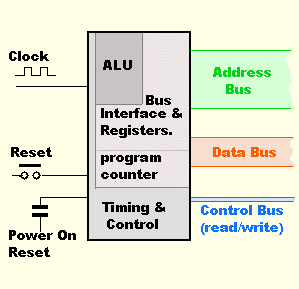The Central Processing Unit

Because timing is so critical, the CPU takes control over virtually everything
that the computer does. If two numbers need to be compared or multiplied, for example,
they are read into the CPU's Arithmetic Logic Unit where the comparison or
mathematics is carried out before the result is written back into memory.
The Registers, shown in the picture, are simply small blocks of memory used by the CPU (and programmers) as a 'scratchpad' for storing temporary results during complex mathematical operations.
One special register is called the 'program counter' which contains the Address of the byte of memory which is currently being addressed. The 'Clock' pulses will, normally, cause the program counter to increment sequentially through the memory unless the Reset button is pressed or the computer power is interrupted - when the program counter automatically resets to all zero's.